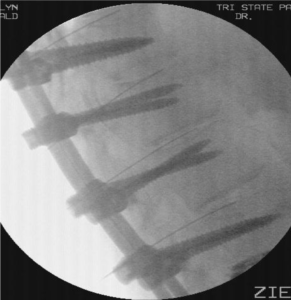Stem Cell Spinal Fusion Surgery
Spinal fusion surgery is commonly performed and is undoubtedly effective in treating some back pain conditions.
122,676 fusion surgeries were performed in 2004. This number has increased by 63% in 2015 to 199,140, reflecting the increasing popularity of this surgery. The largest increases were in patients who were older than 65 years.
In 2015, 10 billion dollars were spent in the US for lumbar fusion surgery at an average cost of $50,000 per procedure. This cost increased by 177% from the year 2004.
Can stem cell therapy be an alternative to fusion surgery?
As stem cell therapy is a new innovation, there are only two studies that reveal that intradiscal stem cells can be a viable alternative to surgery. In one trial, 26 patients were supposed to get fusion surgery. Instead of fusion, these candidates were treated with intradiscal bone marrow stem cells. 88% of these patients got enough pain relief that they avoided fusion. The pain relief obtained after stem cell therapy was sustained even after 5 years.
In another study, 10 patients who were selected to get fusion, received intradiscal stem cell therapy. Fusion could be avoided in 5 of these patients.
Although the evidence is very preliminary, it reveals that intradiscal stem cell therapy can be an alternative to fusion surgery.
Incidence and Causes of Failed Fusion Surgery
A review of the medical literature shows that the spinal surgery failure rate [all spinal surgeries, not just fusions] ranges from 10-46%. The reasons for this are myriad. Some of the causes are
- smoking
- obesity
- depression and anxiety
- wrong diagnosis
- progression of degenerative changes
- altered biomechanics leading to abnormal joint stresses and muscle atrophy/spasm
Unfortunately, most of these patients do not respond to conservative measures and need further surgery. Sadly, repeat spinal surgery is a treatment option with diminishing returns. Although more than 50% of primary spinal surgeries are successful, no more than 30%, 15%, and 5% of the patients experience a successful outcome after the second, third, and fourth surgeries, respectively. What options do these patients have?
Stem Cell Treatment for Spinal Fusion
Marilyn had extensive fusion surgery from her midback to her entire lower back [T9-S1]. The surgery was done to fix her curvature in her spine.
Unfortunately, it did not help and she continued to have pain in her lower thoracic and upper lumbar area. She has tried numerous injections and even strong pain killers which not only failed but also gave her side effects.
She decided to get bone marrow stem cell therapy. Her own bone marrow stem cells were extracted from her iliac crest [bone in the back of the hip]. These cells were further concentrated and then injected back into her thoracic [T9-10, T10-11, T11-T12] discs and lumbar discs [T12-L1, L1-2]. Since then Marilyn had significant improvement in her pain. Most importantly, she says now she’s independent and no longer dependant on her husband to do daily chores.
This is the xray picture of her procedure. Her spinal instrumentation and needles in the discs can be seen.

See the video below to see Marilyn’s response to the treatment.
How successful is spinal fusion surgery?
Fusion surgery is controversial as its success seems to be largely dependant on the spinal condition. For example, in patients with spinal instability resulting from spondylolisthesis and in patients with scoliosis, the results of fusion surgery are very encouraging. However, in common conditions where the spine is stable like disc degeneration, disc herniation, and spinal stenosis, the results from fusion surgery are not very impressive. Despite that, about 42% of spinal fusions in 2015 were done to treat back pain where there was no instability.
Ample evidence exists in medical literature to show that fusion surgery is not superior to nonsurgical treatment when treating discogenic low back pain.
If fusion is not an option for chronic discogenic pain, what choice do patients with refractory chronic back pain have?
Can stem cells salvage failed spinal fusion surgery?
Currently, there are no studies to suggest that stem cell therapy can reduce the pain and suffering of patients with failed fusion surgery. However anecdotally, we are seeing good results in this patient population.
Glenn is another example.
Glenn was suffering from back pain in spite of having a L45 fusion. He was on high dose opioid therapy which was equal to about taking 60 percocets a day. After he underwent stem cell therapy into his discs, facets, nerves and the sacroiliac joint, he is completely off the pain medication and reported a significant improvement in function. Below is the xray image of his procedure.

In this video Glenn describes how this stem cell therapy changed his life
For more videos like this to see how stem cell therapy is helping patients suffering from back pain, click here.
Stem cell therapy is in its infancy but seems to have tremendous potential in patients with back pain. To get the best results, insist on
- using your own bone marrow stem cells
- the procedure is done by an expert
For more information, visit our website.













